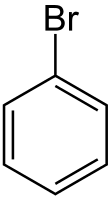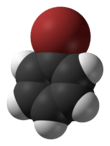Bromobenzene
| |||
| Names | |||
|---|---|---|---|
| Preferred IUPAC name
Bromobenzene | |||
| Other names
Phenyl Bromide; Bromobenzol; Monobromobenzene | |||
| Identifiers | |||
3D model (JSmol) |
|||
| ChEBI | |||
| ChEMBL | |||
| ChemSpider | |||
| ECHA InfoCard | 100.003.295 | ||
| KEGG | |||
PubChem CID |
|||
| RTECS number | CY9000000 | ||
| |||
| |||
| Properties | |||
| C6H5Br | |||
| Molar mass | 157.01 g·mol−1 | ||
| Appearance | Colourless liquid | ||
| Odor | Pleasant aromatic odor | ||
| Density | 1.495 g cm−3, liquid | ||
| Melting point | −30.8 °C (−23.4 °F; 242.3 K) | ||
| Boiling point | 156 °C (313 °F; 429 K) | ||
| 0.041 g/100 mL | |||
| Solubility | soluble in diethyl ether, alcohol, CCl4, benzene miscible in chloroform, benzene | ||
| Vapor pressure | 4.18 mm Hg | ||
| -78.92·10−6 cm3/mol | |||
Refractive index (nD) |
1.5602 | ||
| Viscosity | 1.124 cP (20 °C) | ||
| Hazards | |||
EU classification (DSD) (outdated) |
|||
| R-phrases (outdated) | R10, R38, R51/53 | ||
| S-phrases (outdated) | (S2), S61 | ||
| NFPA 704 | |||
| Flash point | 51 °C (124 °F; 324 K) | ||
| 565 °C (1,049 °F; 838 K) | |||
| Related compounds | |||
Related Halogenobenzenes |
Fluorobenzene Chlorobenzene Iodobenzene | ||
Except where otherwise noted, data are given for materials in their standard state (at 25 °C [77 °F], 100 kPa). | |||
| Infobox references | |||
Bromobenzene is an aryl halide, C6H5Br. It is a colourless liquid although older samples can appear yellow. It is a reagent in organic synthesis.
Synthesis and reactions
Bromobenzene is prepared by the action of bromine on benzene in the presence of Lewis acid catalysts such as ferric bromide.
Bromobenzene is used to introduce a phenyl groups into other compounds. One method involves its conversion to the Grignard reagent, phenylmagnesium bromide. This reagent can be used, e.g. in the reaction with carbon dioxide to prepare benzoic acid.[1] Other methods involve palladium-catalyzed coupling reactions such as the Suzuki reaction. Bromobenzene is used as a precursor in the manufacture of phencyclidine.
Toxicity
Animal tests indicate low toxicity.[2] Little is known about chronic effects.[3][4]
For liver toxicity, the 3,4-epoxide are proposed intermediates.[5]
See also
References
- ↑ G. S. Hiers (1927). "Triphenylstibine". Org. Synth. 7: 80. doi:10.15227/orgsyn.007.0080.
- ↑ e.V., Deutsche Gesetzliche Unfallversicherung. "IFA - Databases on hazardous substance (GESTIS): GESTIS database on hazardous substances". www.dguv.de. Retrieved 2018-03-29.
- ↑ Szymańska, J. A.; Piotrowski, J. K. (November 2000). "Hepatotoxicity of monobromobenzene and hexabromobenzene: effects of repeated dosage in rats". Chemosphere. 41 (10): 1689–1696. ISSN 0045-6535. PMID 11057697.
- ↑ Council, National Research (1977-01-01). Drinking Water and Health,: Volume 1. p. 693. doi:10.17226/1780. ISBN 9780309026192.
- ↑ Integrated Risk Information System, U.S. Environmental Protection Agency. "TOXICOLOGICAL REVIEW OF BROMOBENZENE" (PDF). U.S. Environmental Protection Agency.


